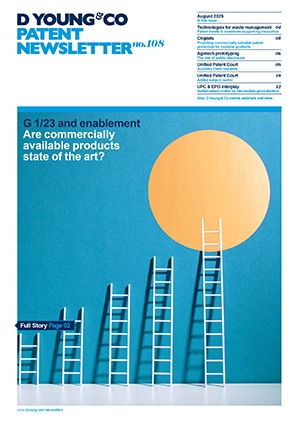Meril v Edwards: inventive step at the UPC
The Paris Central Division of the Unified Patent Court (UPC) found that the claims of Edwards Lifesciences Corporation’s patent EP3646825 as amended were inventive, despite the assertions to the contrary by Meril Italy Srl, Meril GmbH and Meril Life Sciences Pvt Ltd.
The court dismissed the revocation action brought by Meril Italy, and counterclaims brought Meril GmbH and Meril Life Sciences, and EP3646825 was maintained in amended form. This case provides a further insight into how inventive step is assessed at the UPC.
Key points:
- Interpretation of the claims does not depend solely on the strict, literal meaning of the words, and the description and drawings can be used as explanatory aids when interpreting the claims.
- The skilled person can be a team.
- The claimant must provide evidence for an alleged lack of technical effect.
- The skilled person can only combine art from different technical fields if the documents provide strong motivation to do so.
- Inventive step is to be assessed in terms of the specific problem encountered by the skilled person.
- While the problem-solution approach was not used in the assessment of inventive step, the court stated that the problem-solution approach would not lead to a different conclusion.
Background of the case
On 04 August 2023 Meril Italy filed a revocation action against Edwards Lifesciences concerning Edwards Lifesciences’ patent EP3646825. Meril Italy claimed that the patent was not valid for a number of reasons, one of which was a lack of inventive step.
This case involved parallel proceedings, as Meril GmbH and Meril Life Sciences had both filed counterclaims for revocation of EP3646825 on 02 November 2023, in response to a separate infringement action brought by Edwards Lifesciences which was pending before the Munich Local Division. Both counterclaims were identical in their content, and raised some of the same grounds of invalidity that were raised in the revocation action by Meril Italy. The proceedings were therefore consolidated and the counterclaims filed by Meril GmbH and Meril Life Sciences were referred to the Paris Central Division for a decision.
Before the proceedings commenced Edwards Lifesciences filed a number of requests to amend, each containing multiple auxiliary requests. This article focuses on the assessment of inventive step for claim 1 of auxiliary request II submitted by Edwards Lifesciences on 12 April 2024, though we note that other interesting decisions were made by the Central Division in this case, for example, relating to admissibility of amendments and priority.
The oral hearing was held on 07 June 2024.
European patent EP3646825
EP3646825 relates to a prosthetic heart valve which is crimped and mounted on a flexible catheter to prevent or minimize perivalvular leakage. The flexible catheter is then inserted into a patient and travels through the blood vessel of the patient until it reaches the implantation site, where the valve is then expanded to its non-crimped state. Perivalvular leakage (leakage of blood in the opposite direction to the blood flow through the valve) can occur as a result of gaps between the expanded valve and the surrounding tissue. An objective of EP3646825 is to prevent or minimize this kind of leakage with the use of a frame consisting entirely of hexagonal cells (forming a honeycomb shape), which provides a reduced crimping profile, stability during crimping and expansion, and increased radial strength.
Interpretation of the claims
In line with the recent decision in Sanofi-Aventis v Amgen, the Central Division held that the interpretation of the claims does not depend solely on the strict, literal meaning of the words, and that the description and drawings can be used as explanatory aids when interpreting the claims. This diverges from the approach taken by the European Patent Office (EPO), which is more restricted to the content of the claims themselves and refers only the description to clarify any ambiguity present in the claims.
Furthermore, it was stated that the assessment of inventive step must be carried out from the point of view of the skilled person. In this case, the skilled person was considered to be a team consisting of a medical device engineer with an interest in prosthetic heart valves and an interventional cardiologist. This is in line with the approach adopted by the EPO.
Consideration of a technical effect
Meril argued that the features of claim 1 did not provide a technical effect and were merely an obvious alternative. Specifically, Meril argued that simply implementing a frame made entirely of hexagonal cells was not sufficient to achieve the technical effect described in the description, as other parameters may also affect the crimping profile and radial strength.
The court noted that the claimant must provide evidence for the alleged lack of technical effect, in line with the ordinary distribution of the burden of proof. The court concluded that such evidence had not been provided. The court further added that the fact that a feature is not sufficient for achieving a technical effect does not render the feature irrelevant.
Motivation to introduce hexagonal cells
The court stated that the assessment of inventive step must be carried out in accordance with Article 56 of the European Patent Convention (EPC), and was also to be assessed in terms of the specific problem encountered by the skilled person (in line with the decision of the Paris Local Division issued in Dexcom v Abbott).
Meril argued that a frame consisting of hexagonal cells is an obvious and alternative solution to the technical problem, as the prior art discloses the use of hexagonal cells in heart valves. Meril therefore argued that it would be a mere design choice to make the frame entirely from hexagonal cells and that the prior art provided motivation for this.
However, hexagonal cells were only used in the prior art in combination with cells of other shapes (intermediate rhombic cells). When attempting to address the problem of reducing the crimping profile of the heart valve, the court decided that the mere use of hexagonal cells in the prior art would not make it obvious to the skilled person to construct a frame entirely out of hexagonal cells.
Furthermore, the prior art disclosed various other solutions for reducing the crimping profile. One document in particular taught that the use of the intermediate rhombic cells advantageously provided a tapered, collapsed frame. Removing the intermediate cells to produce a frame consisting of entirely hexagonal cells would therefore be inconsistent with the teaching of this document, and this modification would therefore not be obvious to the skilled person.
Thus, the court concluded that the prior art provided no motivation to alter the frames of the prior art to create a frame that consisted entirely from hexagonal cells, and this feature was not obvious.
Both parties agreed that the development of the particular type of prosthetic heart valves discussed (those inserted with a catheter) arose from combining the technology of prosthetic heart valves with technology used in vascular stents.
Meril argued that several vascular stents were entirely made of hexagonal cells and provided radial strength and minimal crimping profile. Meril argued that these would be common general knowledge to the skilled person at the priority date of EP3646825. The court agreed that the skilled person would be aware of vascular stent prior art. However, Meril considered that a reference to prior art in the stent field would require careful consideration and strong motivation for application to heart valve technology.
Such motivation was not found, particularly because the main cited document from the stent field addressed a different technical problem and focused on producing a device that is highly flexible and radially resistant. High flexibility is disadvantageous in heart valves as it may impede a safe anchoring of the valve in the aortic annulus.
Furthermore, radial strength is required in vascular stents to keep the vessel open and prevent restenosis. Therefore, the main document cited from the stent field taught that a honeycomb structure improved the ability of a vascular stent to keep a blood vessel open, but there was no indication that this would also be applicable to heart valves.
Therefore, the court decided that claim 1 was not obvious, even if prior art from the stent field was considered.
Outcome
The claims of auxiliary request II were found to be inventive, and the court rejected the revocation action filed by Meril Italy and the counterclaims for revocation filed by Meril GmbH and Meril Life Sciences. EP3646825 was maintained in amended form.
Final comments
In line with the recent decision in Sanofi-Aventis v Amgen, the court did not follow the problem-solution approach in reaching its conclusions regarding the inventive step of the claims. However, the court still considered the problem encountered by the skilled person and whether the cited documents provided motivation to make the required modifications.
Therefore, although it appears from this case and from the decision in Sanofi-Aventis v Amgen that the UPC intends to diverge slightly from the problem-solution approach adopted by the EPO, the principles for assessing inventive step are largely the same. In fact, the Central Division noted that applying the problem-solution approach would not have led to a different conclusion in this instance.
It should also be noted that the determination of the skilled person was also in line with European practice, as well as the considerations as to whether the cited documents provided motivation for the skilled person to introduce certain features. For example, arguments that the prior art taught other solutions, or that the introduction of features would be inconsistent with the teachings of the prior art, appeared to hold weight in the assessment of inventive step before the UPC.
Case details at a glance
Jurisdiction: UPC Court of First Instance (Central Division Paris seat)
Case: UPC_CFI_255/2023
Order/decision reference: ORD_25123/2024
Parties: Meril Italy Srl & Meril GmbH & Meril Life Sciences Pvt Ltd v Edwards Lifesciences Corporation
Date: 19 July 2024


